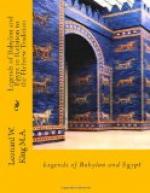It may probably be assumed that the refrain is employed in relation to the same deity in both passages. In the Second Column it precedes the foundation of the Babylonian kingdom and the building of the Antediluvian cities. In that passage there can be little doubt that the subject of the verb is the chief Sumerian deity, and we are therefore the more inclined to assign to him also the opening speech of the First Column, rather than to regard it as spoken by the Sumerian goddess whose share in the creation would justify her in claiming mankind as her own. In the last four lines of the column we have a brief record of the Creation itself. It was carried out by the three greatest gods of the Sumerian pantheon, Anu, Enlil and Enki, with the help of the goddess Ninkharsagga; the passage reads:
When Anu, Enlil, Enki and Ninkharsagga Created the blackheaded (i.e. mankind), The niggil(ma) of the earth they caused the earth to produce(?), The animals, the four-legged creatures of the field, they artfully called into existence.
The interpretation of the third line is obscure, but there is no doubt that it records the creation of something which is represented as having taken place between the creation of mankind and that of animals. This object, which is written as nig-gil or nig-gil-ma, is referred to again in the Sixth Column, where the Sumerian hero of the Deluge assigns to it the honorific title, “Preserver of the Seed of Mankind”. It must therefore have played an important part in man’s preservation from the Flood; and the subsequent bestowal of the title may be paralleled in the early Semitic Deluge fragment from Nippur, where the boat in which Ut-napishtim escapes is assigned the very similar title “Preserver of Life".(1) But niggilma is not the word used in the Sumerian Version of Ziusudu’s boat, and I am inclined to suggest a meaning for it in connexion with the magical element in the text, of the existence of which there is other evidence. On that assumption, the prominence given to its creation may be paralleled in the introduction to a later magical text, which described, probably in connexion with an incantation, the creation of two small creatures, one white and one black, by Nin-igi-azag, “The Lord of Clear Vision”, one of the titles borne by Enki or Ea. The time of their creation is indicated as after that of “cattle, beasts of the field and creatures of the city”, and the composition opens in a way which is very like the opening of the present passage in our text.(2) In neither text is there any idea of giving a complete account of the creation of the world, only so much of the original myth being included in each case as suffices for the writer’s purpose. Here we may assume that the creation of mankind and of animals is recorded because they were to be saved from the Flood, and that of the niggilma because of the part it played in ensuring their survival.




